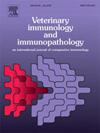Haemonchus contortus parasitic stages development and host immune responses in lambs of different sheep breeds
IF 1.4
3区 农林科学
Q4 IMMUNOLOGY
引用次数: 0
Abstract
Variable host resistance against Haemonchus contortus infection was extensively associated with sheep breed, but the mechanisms responsible for the enhanced resistance remains scarcely elucidated. The aim of the present study was compare the phenotypic profile of three breeds (Santa Inês, Texel and White Dorper) with the relative expression of immune-related genes in the abomasal mucosa of sheep breeds infected with H. contortus. Besides, these phenotypic profiles were compared with relative expression of immune related genes in the animal abomasum. Decreasing resistance against H. contortus infection among sheep breeds was observed in the following order: Santa Inês, Texel and White Dorper. Differential local immune responses were developed during chronic infection, wherein both Santa Inês and White Dorper presented high activity of innate receptors, especially TLR2, while Th2 related transcripts trended to be superior in the Texel lambs. The White Dorper lambs also presented increased local inflammation since most inflammatory related genes, including the pro-inflammatory mediators NFKBIA and IL1B, and anti-inflammatory cytokines IL10 and TGF were upregulated. The host responses to different parasite stages were characterised by TLR2 activity during earlier stages, while complement activity (CFI) was involved in the clearance of latter parasite stages. Further, TLR4 activity affected the responses to both early and late parasite stages. To our knowledge, this is the first study to point out for differential immune responses among sheep breeds and to different H. contortus parasitic stages. The better elucidation of these host-parasite interactions may improve the immune-prophylactic management of haemonchosis.
不同绵羊品种羔羊弯曲血蜱寄生阶段发育及宿主免疫反应
宿主对扭曲血蜱感染的可变抗性与绵羊品种广泛相关,但抗性增强的机制尚未阐明。本研究的目的是比较3个品种(Santa Inês、Texel和White Dorper)的表型特征和感染扭曲螺旋体的绵羊品种皱胃黏膜中免疫相关基因的相对表达。并将这些表型与动物皱胃免疫相关基因的相对表达量进行了比较。不同绵羊品种对弯曲螺旋杆菌感染的抵抗力下降的顺序依次为:Santa Inês、Texel和White Dorper。在慢性感染期间,出现了不同的局部免疫反应,其中Santa Inês和White Dorper都表现出高活性的先天受体,特别是TLR2,而Th2相关转录物在Texel羔羊中表现出更强的活性。由于大多数炎症相关基因,包括促炎介质NFKBIA和IL1B,以及抗炎因子IL10和TGF上调,白杜伯羊也出现了局部炎症的增加。宿主对不同寄生阶段的反应表现为TLR2在早期阶段的活性,而补体活性(CFI)参与后期寄生阶段的清除。此外,TLR4活性影响了寄生虫早期和晚期的反应。据我们所知,这是第一个指出不同绵羊品种和不同弯曲螺旋虫寄生阶段的不同免疫反应的研究。更好地阐明这些宿主-寄生虫相互作用可能会改善血病的免疫预防管理。
本文章由计算机程序翻译,如有差异,请以英文原文为准。
求助全文
约1分钟内获得全文
求助全文
来源期刊
CiteScore
3.40
自引率
5.60%
发文量
79
审稿时长
70 days
期刊介绍:
The journal reports basic, comparative and clinical immunology as they pertain to the animal species designated here: livestock, poultry, and fish species that are major food animals and companion animals such as cats, dogs, horses and camels, and wildlife species that act as reservoirs for food, companion or human infectious diseases, or as models for human disease.
Rodent models of infectious diseases that are of importance in the animal species indicated above,when the disease requires a level of containment that is not readily available for larger animal experimentation (ABSL3), will be considered. Papers on rabbits, lizards, guinea pigs, badgers, armadillos, elephants, antelope, and buffalo will be reviewed if the research advances our fundamental understanding of immunology, or if they act as a reservoir of infectious disease for the primary animal species designated above, or for humans. Manuscripts employing other species will be reviewed if justified as fitting into the categories above.
The following topics are appropriate: biology of cells and mechanisms of the immune system, immunochemistry, immunodeficiencies, immunodiagnosis, immunogenetics, immunopathology, immunology of infectious disease and tumors, immunoprophylaxis including vaccine development and delivery, immunological aspects of pregnancy including passive immunity, autoimmuity, neuroimmunology, and transplanatation immunology. Manuscripts that describe new genes and development of tools such as monoclonal antibodies are also of interest when part of a larger biological study. Studies employing extracts or constituents (plant extracts, feed additives or microbiome) must be sufficiently defined to be reproduced in other laboratories and also provide evidence for possible mechanisms and not simply show an effect on the immune system.

 求助内容:
求助内容: 应助结果提醒方式:
应助结果提醒方式:


